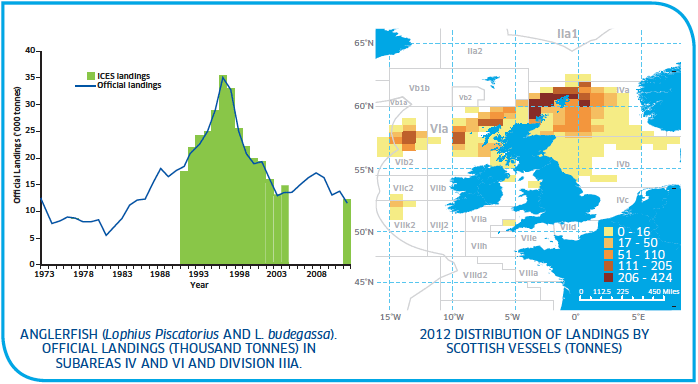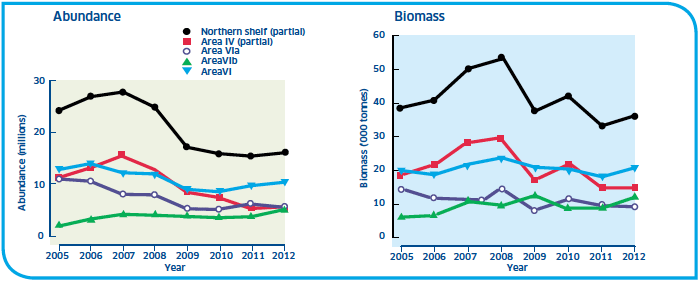Revised editon: Fish and Shellfish Stocks: 2014 Edition
Information on the state of fish and shellfish stocks of commercial importance to the Scottish fleet, inclduing Total Allowable Catches (TACs) for each stock.
Monkfish Stocks (North Sea and West of Scotland)
Monkfish (Lophius piscatorius and Lophius budegassa) also known as anglerfish. Although only fourth by weight, they were the second most valuable fish species landed into Scotland in 2010. Caught mainly by bottom trawl gear in the northern North Sea to the north and west of Scotland, close to the shelf edge.
2014 position : UK share 7,739 tonnes
Last Year : 8,866 tonnes
Landed into Scotland in 2012 : 6,426 tonnes
Value for 2012 : £20 million
Biology
There are two species of anglerfish, also called monkfish, in Scottish waters. The black-bellied monkfish, L ophius budega s sa, is much less common than the 'white' monkfish, L ophius pis c atorius. The basic biology of the two species is very similar.
Monkfish occur in an unusually wide range of depths, extending from very shallow inshore waters down to at least 1,100m. Small monkfish can be caught over most of the northern North Sea and west coast grounds, down to about 150m. Large fish, the potential spawners, used to be found at all depths, including inshore waters, but are now scarce in water shallower than 100-150 m.
Spawning takes place mainly during the first six months of the year and is believed to occur in relatively deep water. Although monkfish have a long spawning season, each female probably produces only one batch of eggs, unlike cod, haddock and whiting, which spawn many times during a single spawning season. Female monkfish only begin to reach maturity around the age of seven years when they have grown to a length of about 70cm. The majority of females do not spawn until they are even older and are therefore likely to be caught long before they reach full maturity. Monkfish have very unusual spawning habits. The eggs are released in a huge ribbon of jelly that floats to the surface and drifts with the currents. A single egg ribbon can be more than 10 metres long and can contain well over 1 million eggs. After hatching, the young monkfish spend three or four months in mid- water, before settling on the bottom at a size of 5-12cm. During their time in mid-water the young fish may drift a very long way from the spawning grounds.
Monkfish feed mainly on fish, although shellfish and even seabirds are sometimes found in their stomachs. They lie on the seabed and attract prey to within range of their enormous mouths by twitching a 'fishing rod', or lure, that extends from the top of the head, in front of the eyes.

ICES Advice on Management
Information Source: ICES advice 2013 http://www.ices.dk/sites/pub/Publication%20Reports/Advice/2013/2013/ang-ivvi.pdf. Quoted text in italics.

ANGLERFISH ( L ophius pis c atorius AND L. budega s sa). TOTAL ABUNDANCE (MILLIONS) AND STOCK BIOMASS (THOUSAND TONNES) INDEX FROM SCO-IV-VI-AMISS-Q2 (black filled circles with 95% confidence limits, labeled as "Northern shelf (partial)"), WITH BREAKDOWN BY AREA: SUBAREA IV (red squares), SUBAREA VI (grey triangles), DIVISION VIa (blue open circles), AND DIVISION VIb (green triangles).
MSY and precautionary approach reference points
| Type | Value | |
|---|---|---|
| MSY Approach | M S Y Btrigger | Not defined |
| FMSY | Not defined | |
| Precautionary Approach | Blim | Not defined |
| Bpa | Not defined | |
| Flim | Not defined | |
| Fpa | Not defined | |
| Qualitative evaluation |  |
Decreasing |
State of stock and advice
- No accepted analytical assessment can be presented for this stock.
- Recent dedicated anglerfish surveys, the Scottish and Irish anglerfish and megrim industry/science survey for the Northern shelf (SCO-IV-VI-AMISS-Q2) in Division IVa and Subarea VI, indicate a decline in abundance and biomass since 2008.
- No reference points have been defined for these stocks. Previous reference points are no longer considered to be valid. The available information is insufficient to evaluate exploitation status. Therefore, catches should be reduced.
- No management objectives are known to ICES.
The basis for the advice this year is the same as last year, i.e. ICES approach to data-limited stocks. Previous concerns about underreporting of landings are no longer considered an issue, and therefore ICES is able to provide quantified advice this year.
ICES advises that catches should be reduced by 20% in relation to the average of the last three years, corresponding to catches in 2014 of no more than 10 231 t. All catches are assumed to be landed.
Genetic and particle-tracking studies have determined that the monkfish caught in the North Sea and those caught to the west of Scotland come from the same biological stock.
Management outcomes for 2014
In April 2014 at the Council of Ministers meeting in Brussels, the EU Total Allowable Catch for the northern shelf (IV and VI, EC waters of IIa and Vb, and international waters of XII and XIV) monkfish was set at 12,265 tonnes, with the UK quota for 2014 at 7,739 tonnes.
Contact
There is a problem
Thanks for your feedback